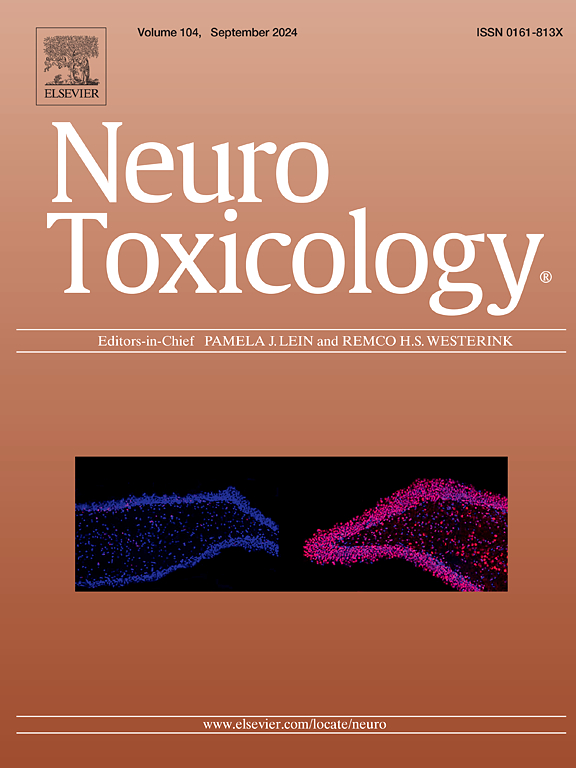地奎特对中枢神经系统的毒理学影响及相关治疗挑战
IF 3.9
3区 医学
Q2 NEUROSCIENCES
引用次数: 0
摘要
diquat是一种剧毒的吡啶类除草剂,其中枢神经系统(CNS)毒性是中毒患者高死亡率和神经预后不良的主要因素。与其他器官损伤相比,diquat诱导的中枢神经系统损伤的复杂分子机制和有效的神经保护策略尚不清楚。方法系统检索和筛选有关diquat致中枢神经系统毒性的相关文献。根据预先设定的纳入和排除标准,从424篇检索记录中选择21篇文章,包括11篇实验研究和10篇案例研究。采用系统评价方法,将基础研究与临床证据相结合。结果本研究确定了双胍中毒引起的中枢神经系统损害的典型临床表现(如意识受损、抽搐和脑干症状),以及特征性影像学表现(如基底节区和脑干病变)。核心发现强调了diquat诱导的神经损伤的六个主要机制:过度激活氧化应激反应;明显的神经炎症级联反应;自噬功能失调;凋亡信号通路的激活;线粒体功能障碍;神经递质系统也发生了重大变化。这些机制相互关联,共同导致神经元死亡和功能损害。结论diquat可通过多种相互关联的分子机制引起严重的中枢神经系统损伤。目前的诊断和治疗策略在改善神经预后方面面临重大挑战,特别是由于缺乏特异性解毒剂和靶向神经保护剂。未来的研究应旨在详细阐明其潜在机制,探索新的神经保护靶点,优化综合治疗方案,并制定长期康复策略,以减少与diquat中毒相关的神经功能损害和死亡率。本文章由计算机程序翻译,如有差异,请以英文原文为准。
Toxicological effects of diquat on the central nervous system and associated treatment challenges
Background
Diquat is a highly toxic pyridine-based herbicide, and its central nervous system (CNS) toxicity is a major factor contributing to the high mortality rate and poor neurological outcomes in poisoned patients. Compared with other organ injuries, the complex molecular mechanisms underlying diquat-induced CNS damage and effective neuroprotective strategies remain poorly understood.
Methods
A systematic search and screening of relevant literature on diquat-induced CNS toxicity were conducted. Based on predefined inclusion and exclusion criteria, 21 articles were selected from 424 retrieved records, including 11 experimental and 10 case studies. A systematic review approach was employed to integrate basic research with clinical evidence.
Results
The study identified typical clinical manifestations of CNS damage caused by diquat poisoning (e.g., impaired consciousness, convulsions, and brainstem symptoms), along with characteristic imaging findings (e.g., lesions in the basal ganglia and brainstem). The core findings highlight six major mechanisms underlying diquat-induced neural damage: excessive activation of the oxidative stress response; pronounced neuroinflammatory cascade reactions; dysregulated autophagy function; activation of apoptotic signaling pathways; mitochondrial dysfunction; and significant alterations in the neurotransmitter system. These mechanisms are interrelated and collectively lead to neuronal death and functional impairment.
Conclusions
Diquat induces severe CNS damage through multiple interrelated molecular mechanisms. Current diagnostic and therapeutic strategies face significant challenges in improving neurological outcomes, particularly due to the lack of specific antidotes and targeted neuroprotective agents. Future research should aim to elucidate the underlying mechanisms in detail, explore novel neuroprotective targets, optimize comprehensive treatment protocols, and develop long-term rehabilitation strategies to reduce neurological impairment and mortality associated with diquat poisoning.
求助全文
通过发布文献求助,成功后即可免费获取论文全文。
去求助
来源期刊

Neurotoxicology
医学-毒理学
CiteScore
6.80
自引率
5.90%
发文量
161
审稿时长
70 days
期刊介绍:
NeuroToxicology specializes in publishing the best peer-reviewed original research papers dealing with the effects of toxic substances on the nervous system of humans and experimental animals of all ages. The Journal emphasizes papers dealing with the neurotoxic effects of environmentally significant chemical hazards, manufactured drugs and naturally occurring compounds.
 求助内容:
求助内容: 应助结果提醒方式:
应助结果提醒方式:


